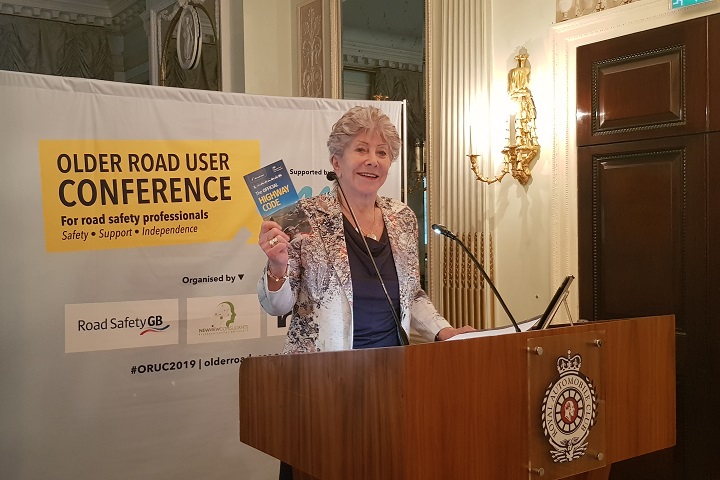
Live reporting from the 2019 Older Road User Conference, which is taking place at the prestigious RAC Club on London’s Pall Mall.
Summary
- Second edition of the Older Road User Conference
- Designed to help road safety professionals keep older people safe on the roads for longer
- Taking place at the RAC Club, London, on 24 September
- Click here to see the agenda
This page does not automatically refresh – click here to read the latest entries.
15.20 – Naomi Baster, Principal City Planner, Transport for London
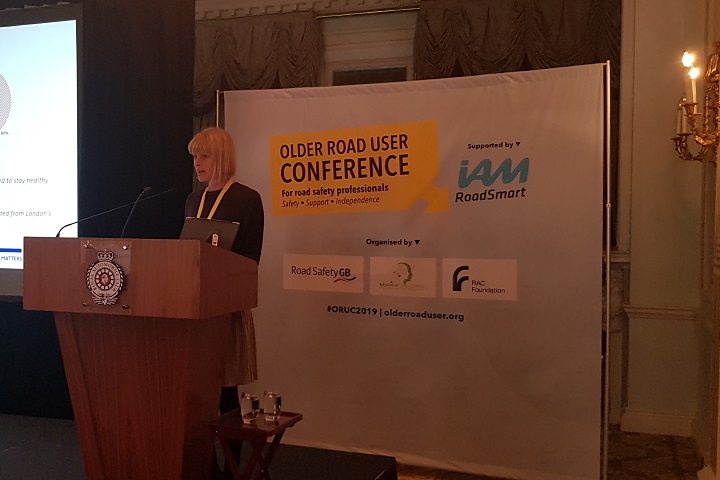
Following six years experience in road safety policy at TfL, which included developing London’s Vision Zero approach, Naomi currently works in the Active Travel and Health team, which is responsible for enabling more people to walk, cycle and use public transport by putting people and their health at the heart of decision making.
Presentation: Older people and the Mayor’s vision for transport in London
The proportion of people in older age groups is lower in London than UK average
Difficulties include:
- Overcrowding
- Anti-social behaviour
- General discontent about streets
There are fewer older people KSI than younger people – but adjusting for population shows they face similar levels of risk
TfL approach
Need an environment to encourage older people to get out more and be more active
‘Healthy Streets’ approach designed particularly with the most vulnerable people in mind
Health Street indicators – include: easy to cross, clean air, things to see and do, easy for pedestrians.
What does the ideal walking environment look like?
- Places to meet nice people
- Minimal or low speed cars
- Clean
- Somewhere to sit down
- Attractive little roads
Vision Zero approach aligned with the Health Streets approach – reduce danger and encourage people to walk and cycle
15.00 – Ellie Wooldridge, Senior Human Factors Researcher, Connected Places Catapult

Ellie Wooldridge works predominantly in the transport sector, exploring the interactions between people and automated technologies.
Presentation: Keeping independence by providing alternative and appropriate future transport mode options
Issues among older people
Visual:
- Decline in visual acuity and/or contrast sensitivity
- Visual field loss
- Reduced dark adaptation and glare recovery
Auditory:
- Loss of auditory capacity
Cognitive:
- Decline in attentional and/or cognitive processing ability
- Reduced memory function
Physical:
- Musculoskeletal declines and strength loss
- Postural control and gait changes
Cognitive + Physical:
- Slowed reaction time
- Reduced perceptual performance
- Reductions in motor perception
Most older drivers don’t travel as often – and found longer journeys more difficult
People are retiring much later
Focus on the road across different age groups
Older drivers:
- Road features
Human drive – funded by Innovate UK
- How to make autonomous driving more human like
- Designed to enhance the user comfort, safety and experience
Overtrust in systems is leading to dangerous driving.
Utilising other modes
- Not considered in the planning phase for later life
- Higher car dependency throughout life = difficulty adopting other modes
- Lack of alternative transport options = high risk of social exclusion
“For every £1 invested in tackling loneliness, £3 is saved in health costs” – opportunity for transport
Concerns for older people include navigation
14.40 – Yvette Bateman, Chief Executive Officer, East Anglian DriveAbility & Vice-Chair, Driving Mobility
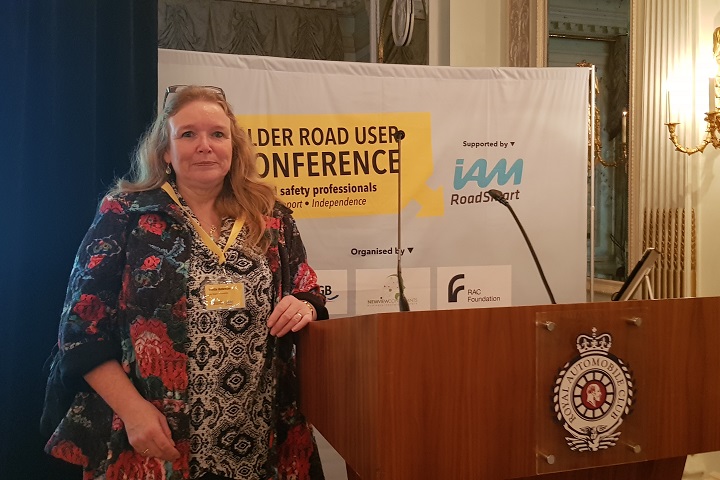
Yvette Bateman has been a qualified occupational therapist for nearly 30 years and has worked in many fields including care of the elderly, stroke rehabilitation and neuro-rehabilitation.
Presentation: Fitness to drive & preparing for life after driving – Regional Transportation Hubs
What do we offer at our Centres?
- Assessment (not a driving test – can last up to two hours)
- Clinical Consultation
- Assessment – Physical (any adaptations that could help a person continue driving)
- Assessment – Cognitive (concentration, switching attention between tasks)
- On-road Assessment (dual controlled car, standardised routes)
Assessment conclusions and next steps
- Driving Cessation
- Preparing for change
How will I know when to stop?
- Family make comments
- Other drivers seem intolerant, hooting horn or gesticulating
- Hitting kerbs, small prangs
- Using a co-pilot
- Confusion at exits
- Incorrect use of lanes
- Not noticing road signs
Staying in the driving seat – key is thinking about alternatives
Who can help me? – relatives
14.20 – Graham Mylward, Senior Road Safety Officer, Hampshire County Council
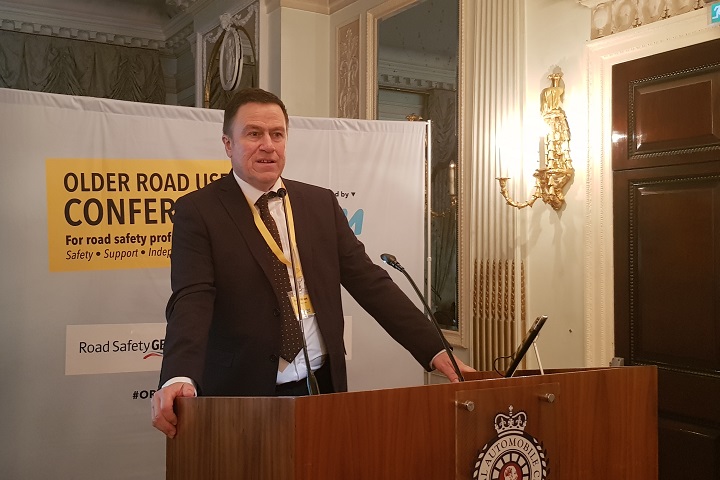
Graham Mylward has led on Hampshire’s Driver Skills Scheme 60+ for 10 years. In this time he has observed driver behaviour in many different situations and worked closely with other local agencies, including the local Driving Mobility Centre.
Presentation: The road to retirement from driving
“The long and winding road” – Paul McCartney
Where do older drivers go for advice?
- RoSPA
- IAM RoadSmart
- DVSA
- Older Drivers Forum
Need to catch the people who are showing warning signs of having a collision.
- Simple assessment
- A confidence builder
- A run around the block with an ADI
Fitness to Drive is a medical decision.
What happens when we develop a medical condition?
- Report to DVLA
- Medical enquiry
- Assessment at Driving Mobility Centre (<10%?)
- GP reports on Fitness to drive
Where can drivers with cognitive impairment go for help?
Older drivers often only want to drive to the shops!
In a trial, 75% of all drivers referred to a Driving Mobility Centre didn’t go for assessment.
Driver Skills Scheme 60+
What changes have been made to Driver Skills Scheme 60+ to make it fit for purpose when assessing drivers with cognitive impairment?
- Specific training for ADIs
- Standardisation of how risk levels are recorded
- Development of a good working relationship with Wessex DriveAbility
- Follow up when concerns are reported
- Development of a basic understanding about how cognitive impairment may affect driving
- A revised report format aimed specifically at informing doctors about driving capabilities
Summary:
- Increased availability of standard advice services
- Train the trainer course
- Increased emphasis on specialist advice services
- Specialist train the trainer courses
Conclusions:
- Autonomous vehicles are seen to hold great promise – in particular for those that see reduced mobility, and problems in accessing transport
- Some visions of a future based on autonomous vehicles suggest there will be major road safety benefits – helping older people particularly
- But there are still many challenges to be overcome to reach that future
14.00 – Dr Duncan Guest, Associate Professor in Psychology, Nottingham Trent University
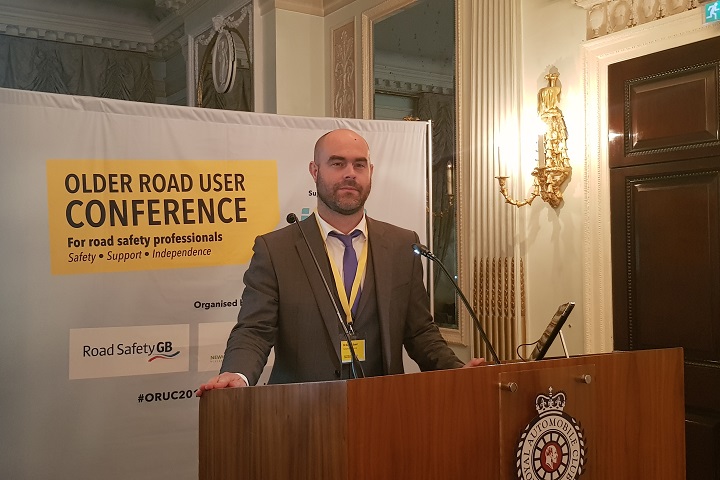
Dr Duncan Guest has recently been the principal investigator on a two year project on hazard perception in mobility scooter users at road crossings, funded by the Road Safety Trust and undertaken by the Transport Research in Psychology research group at Nottingham Trent University.
Presentation: Hazard perception at road crossings in mobility scooter users
Number of mobility scooter users in the UK – 300-350,000
- Increase at a rate of 5-10% per years
Mobility scooters and hazards:
- 18% of mobility scooter users reported collisions during a 3 month period
- 2014: 209 reported accidents
- 2017: 52 reported incidents with pedestrians (pedal bikes 506)
Provide increased quality of life, self esteem and independence
Issues about safety and social and economic cost of abandonment
Majority of training programs focus on vehicle handling – scooters are hard to handle
Road Safety Trust Project – what are we doing?
Focus on hazards at road crossings (marked/unmarked)
Questionnaire:
- Only 38% had completed training
What is hazardous?
- Traffic and other drivers
- Spacing issues
- Visibility issues
Developed a training package called ‘See & Scoot’
- 20 min hazard perception training video
- Free to use
- Positive feedback from users and the industry
- Range of organisations are using it
Evaluation – increased awareness of the range of strategies to negotiate hazards
Summary
- Evidence of a lack of training
- For a desire for more training from the community
Future directions:
- What the videos tell us about the built environment
- Understanding negative perception of users
- Education
- Other forms of training
12.20 – Rianne N.M. Hogenbirk, MSc
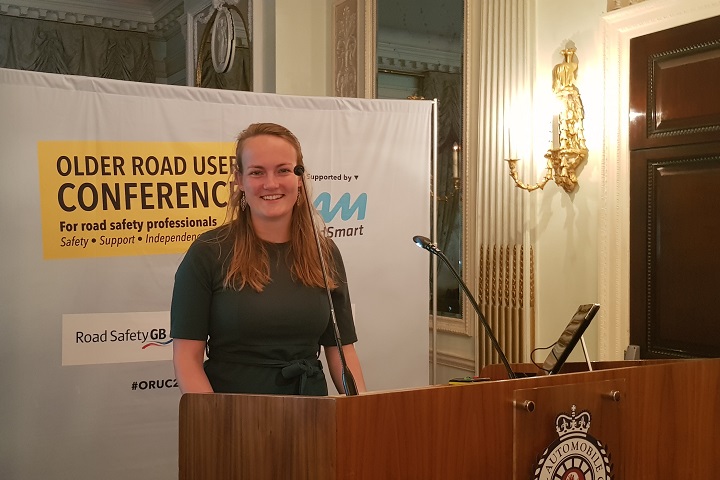
Rianne Hogenbirk has recently graduated from medical school and is currently working at a surgery department in the Netherlands. She is part of a research group on (E)-bicycle accidents in the Trauma Surgery Department at the University Medical Center in Groningen.
Presentation: For the elderly road user: Is the E-bike a solution or a danger?
- 23,000,000 bicycles in NL
- 70,000 bicycle accidents per year
- 200 bicycle accident deaths per year
- 33% of total traffic fatalities
- Introduction of E-bikes in late 90s
E-bikes:
- 1,900,000 in NL
- Supports 25-27km/h (compared to 18km/h with conventional cycling)
- Weight: 9kg heavier (makes balance of the bike different to conventional bike)
E-bikes are increasing massively in popularity, not just amongst older people
Prospective cohort study (Level 1 trauma center in the Netherlands – July 2014 – May 2016)
- Injury Severity by AIS (98)
- Propensity score matching – age, gender and comorbidities (presence of one or more additional disorder/disease)
Results of study
475 bicycle accidents – 107 E-bikes (22.5%)
- Mean age: 65y
- Comorbidity present: 80%
368 conventional bicyclists (77.5%)
- Mean age: 39y
- Comorbidity present: 37%
No difference in type of accident – but helmet use in only 1 e-biker
More spinal/lower body injuries among e-bikers
Before matching:
- E-bikers higher severity score
- E-bikers more often polytraumatized
Injuries separately:
- Head, face, upper- and lower extremity
After matching:
- E bikers more often polytraumatized
Injuries separately:
- Head injury
Older road user have more serious injuries (and spend longer in hospital) than younger road users.
Conclusions
- E-bike accidents occur more frequently in elderly
- E-bikers: – More often polytraumatized – More severe head-injury – Longer duration of hospital admission
- More research is needed to make recommendations on preventive measures
12.00 – Elisabetta Carattin, Inclusive Design Consultant, ARUP & Rosie Holding, Senior Evaluation Officer, Sustrans
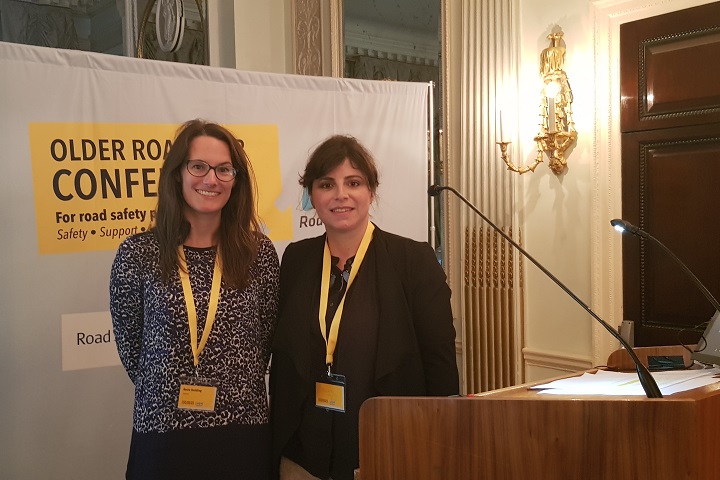
Rosie Holding works in the Research and Monitoring Unit at Sustrans, primarily coordinating the data collection for Bike Life, the UK’s largest assessment of cycling development in cities.
Presentation: Designing cities for older people to cycle
Sustrans and Arup have partnered to explore the topic of inclusive cycling:
- What is stopping people from cycling more?
- How can this be overcome?
Background: Bike Life
These groups are under-represented:
- Women
- Older people (65+)
- Disabled people
- BAME
- Lower socio economic background
In the UK, older people cycle less than any other adult age group
Focus group – feedback
Fear and lack of access to cycle training prevent older people from cycling – “I’m frightened to cycle as my reactions aren’t as quick.”
Many older people who cycle only cycle for leisure
Older cyclists have greater concern about road safety – “I feel quite vulnerable getting out and going onto the street”
Other countries have higher levels of cycling among older people – 24% of trips by over 65s in the Netherlands are by bicycle
Stage 1 of the study focused on disability, women and older persons – There was a large overlap and therefore common ground across the different groups, with recommendations falling under three complementary themes:
Better governance
- Representation
- Views and needs represented
- Culture change
Improving places
- Plan better routes for all, offering choice for different levels of experience and confidence
- Prioritise active travel over motorists
- Cycle facilities to support this as a mode of transport (e.g. storage)
Supporting people to cycle
- Access to alternative cycles
- Training
- Promoting cycling
Next steps:
- Identify global case studies
- Use study to facilitate discussion and challenge the urban transport sector to think about how we can improve cycling infrastructure to be more inclusive
- Refine and test the recommendations
11.40 – Dr Ben Spencer, Research Fellow, Oxford Brookes University
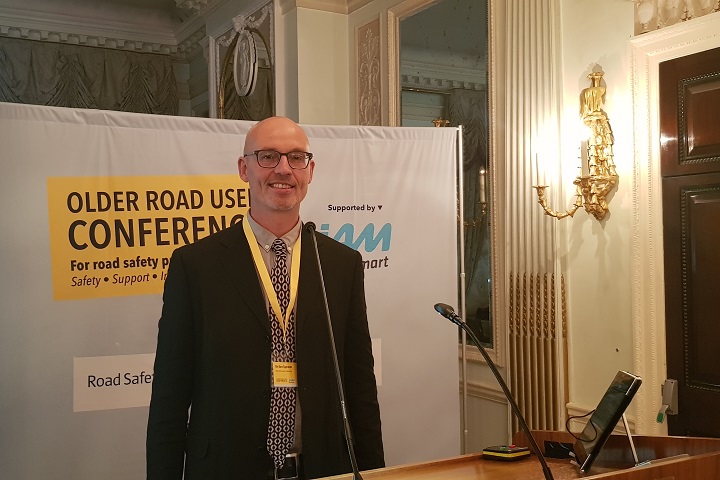
Dr Ben Spencer is a Research Fellow at the School of the Built Environment, Oxford Brookes University.
His research focuses on how urban environments can be (re)configured to support and promote sustainable and healthy urban mobility, particularly walking and cycling
Presentation: Cycling beyond your sixties – Older people’s experience of cycling in UK cities and impacts on health and wellbeing
Background:
- Population across most of Europe is ageing
- People living longer and birth rate falling
- Push to encourage people to stay active for longer – reduce end of life morbidity
- Mobility & independence important constituents of wellbeing in later life
‘Low level of cycling among older people in the UK, but a different story elsewhere’
‘Resilient riders – older people who regularly cycle’
- Small minority
- Positive antecedent state towards cycling
- Tend to be physically active in other areas of their lives
- Majority also car drivers
- Acclimatised to changes over time and adapted their style of riding to deal with changing conditions and capabilities: timing, route choice, equipment
- Critical of infrastructure and current conditions for cycling which impacts moment-by-moment wellbeing
- Question whether they would have been able to re-engage with cycling nowadays if they hadn’t acclimatised over time
Sharing space with vehicles
- Cycling among motorised traffic perceived as risky
- Particular concern over busses and heavy goods vehicles
- Speed and proximity key
- Strategies and tactics to avoid danger
Sharing space with pedestrians
- More relaxing than sharing with vehicles
- Concern over pedestrians – children and dogs
- Preference for separated cycle tracks on main roads
Sources of positive affect
- Slower traffic
- Separated cycle space
- Green/blue spaces
- Descending hills (exhilaration)
- Good, consistent surfaces
- Good visibility
- Good continuity
- Few traffic lights
- Few parked cars
- Absence of clutter
- Social encounters
Age friendly cycling recognitions
Outdoor space & buildings
- Outdoor space needs to offer a safe, comfortable and enjoyable experience for cycling
- Stimulate positive impact on wellbeing
Transportation
- Recognise the full potential of cycling as a mobility aid for older cycling
- Seamless integration with other modes
- Capitalise on the growing e-bike market
People enjoy e-bikes – there is an element of thrill and excitement associated with them, and people can cover greater distances
On average people used the e-bike assistance for 15% of their journey
E-bikes have the potential to deliver significant health and wellbeing benefits
10.50 – Ian Shergold, Research Fellow, University West of England

Ian Shergold has been working at the Centre for Transport and Society since 2007, and has been involved in a wide range of research projects over that time. These have primarily related to three key areas of interest: older people and transport, rural transport issues and technology and transport.
Presentation: What might the widespread adoption of fully-autonomous vehicles mean for older people’s mobility and their safety on the road?
A mobility vision for the future:
A world in which people walk, cycle, and use a shared fleet of electric autonomous vehicles to get around. There might be no private cars or parking, more efficient land use, more affordable urban housing, and built environments that better promote community. In this world, adults seamlessly maintain their social connections and activities outside the home as they age
‘Fully autonomous vehicles will potentially revolutionise transport, especially for the less mobile, including older people’
What do we mean by autonomous vehicles, or driverless cars specifically?
- Autonomy builds on driver aids, e.g. Advanced Driver Assistance Systems (ADAS)
- Levels of autonomy: 1-5 (5 = no steering wheel or pedals, hands off, eyes off)
- Mobility equity relies on level 5
The Flourish project: Our goals and approach
Goal: to advance the successful implementation on CAVs in the UK
Three year, multi-million, co-funded by industry. Delivered in partnership with Innovate UK. Supports the future of mobility grand challenge.
Research question: How might the technology be harnessed to enhance and enable mobility for older adults and those with mobility-related conditions – contributing to the development of a more inclusive society?
Method:
- User focused approach – over 230 members of the public involved in research
- Younger-old and older-old
- 100 older people in simulator and live vehicles
- Trials, focus groups, workshops and interviews
- Particular focus on interaction on the vehicle
My research focus: older people’s mobility needs, journey purpose, wellbeing and social cohesion benefits.
What do participants think are the benefits of fully autonomous vehicles?
- Convenience
- Independence
- Health and wellbeing
- Socialising
Road safety – safer drivers:
- Road traffic accidents – 1,770 road deaths, 26,610 people killed or seriously injured in UK in 2018 (DfT 2019)
- 85% of road accidents (globally) resulting in injury are a result of human error (WHO 2018)
- Increased chances of injury or death for older people in an accident
- Risk that some older people drive longer than they are safe
- Some claim 90% reduction in accidents if we were all travelling in AV (McKinsey & Co 2015)
Road safety – safer roads:
- Connectivity – to other vehicles, to the road network and the internet / ‘cloud’
- No surprises, vehicles able to see around corners
- Connectivity already here in vehicles: Information, emergency help, vehicle diagnostics
- All vehicles connected within next 5-10 years
Road safety – safer streets:
- Shared-mobility model could mean significant reduction in parking in streets
- All-electric vehicles would mean better air quality
- Potential for fewer falls
- Supports more walking / physical mobility
Delivering autonomous vehicles for older people – policy and planning challenges:
- Services for new settlement patterns
- Meeting additional travel demands
- Addressing heterogeneity in the older population
- Planning for older people’s mobility
- Operating models to maximize benefit (community travel, Uber style model etc?)
How will we achieve the most desirable outcomes?
How do you ensure that there is equity in the delivery of autonomous mobility?
Will road safety benefits be seen without strong policy direction?
Delivering AV for older people – Implementation challenges:
- Technical – HMI
- Digital divide
- Cost of vehicles / services
- Rural / urban
How do you address these issues?
Who is responsible?
How do you ensure that there is equity in the delivery of autonomous mobility?
Conclusions:
- Autonomous vehicles are seen to hold great promise – in particular for those that see reduced mobility, and problems in accessing transport
- Some visions of a future based on autonomous vehicles suggest there will be major road safety benefits – helping older people particularly
- But there are still many challenges to be overcome to reach that future
10.30 – Dan Campsall, Marketing & Communications Director, Agilysis
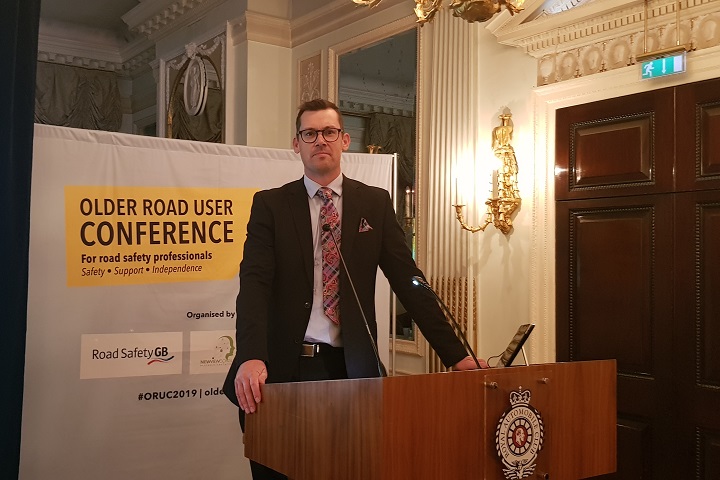
Joining the Road Safety sector in the early 2000’s, Dan has played key leadership roles in programmes with national significance including multi-award-winning projects such as MASTonline, CrashMap.co.uk and DriveStart.
Presentation: Older Road User Safe Mobility Knowledge Programme
Two important pieces of recent work:
- Older Drivers Task Force
- Fit to Drive – by PACTS
To take forward the work of the Older Drivers Task Force by widening its scope to address the risks to older road users, concentrating on the most vulnerable.
‘‘to deliver a digital platform which shares a best practice review of road safety risks for older road users’’
Policy landscape review: fair, accessible and safe mobility in later life
Pillar studies: safe vehicles, safe roads & mobility, safe road users, post-crash response
What is going to be impacting on those looking to drive at later life?
- Transport, social care, health, culture & environment, justice, planning
Number of gaps that need to be considered – one of which relates to understanding. Things changing in wider society.
Looking for international examples of good practice.
So what are some of the themes that are emerging:
- Mobility Deprivation: people’s ability to access services, connect socially, engage with culture, enjoy volunteering opportunities, reach family, are all influenced by mobility.
- Social Polarisation: often older populations are more static, but changes in the composition of the community around them can drastically change their experience of society.
- Policy Integration: the best places are thinking more systematically about addressing the needs of an ageing population – they are reducing barriers by considering the wide range of things that older citizens are looking for.
- Well-being interventions: throughout this piece of work, we are looking to populate it and the digital knowledge platform with examples of interventions that work.
GET INVOLVED – oldermobility.com (coming soon) – a call to share examples of good practice
Digital platform expected to launch in spring 2020
10.10 – Alan Kennedy Executive Director, Road Safety GB & Ian Edwards, Director, NVC
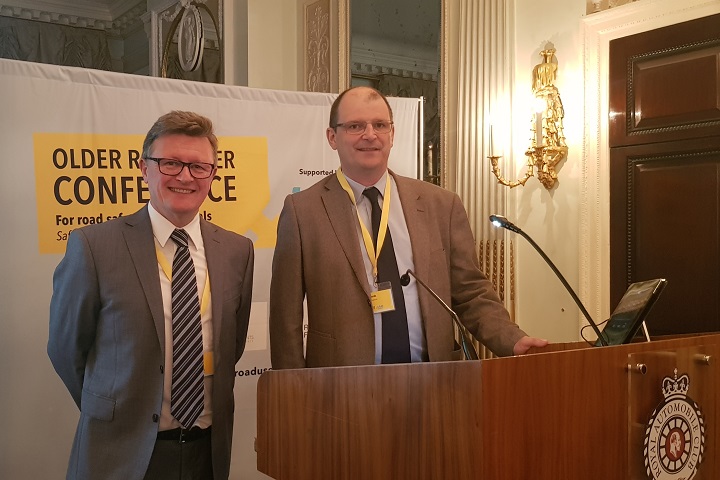
Alan Kennedy, who has been working in road safety for more than 25 years, became Road Safety GB’s first full time business manager in April 2014.
Ian Edwards is an independent road safety consultant who has developed and delivers several of Road Safety GB’s courses, including the Foundation and Behavioural Change course.
Presentation: Instructor Training to Support Elderly Driver Schemes
Background:
- Older Driver Task Force
- ORUC 2018 a number of presenters indicated that the specific needs of elderly drivers may not have been met
- Road Safety GB applied for a grant to DfT to research the specific needs of older drivers and to develop a training intervention to improve the knowledge of ADIs in this area
- Road Safety GB is seeking to form an older driver advisory group and will be contacting people in the coming weeks
Why provide instructor training?
- Improve levels of instructor awareness
- Provide a resource for other organisations to use (a pool of ADIs)
- Improve the training given to other driver training groups/individuals in relation to improving knowledge and understanding of the issues experienced by elderly:
- Drivers
- Riders
- Pedestrians
Deliverables:
- Develop a training package for ADIs (based on education rather than assessment, structured approach)
- Deliver this training to 300 ADIs
- Evaluate the package
- If you are a driving instructor and would like more information, please let us know
The development process:
- Literature review
- Develop training materials and support materials
- Pilot and adjust
- Deliver to ADIs – at a number of centres
Literature review
Areas of interest:
- Hazard perception skills (decline as drivers age)
- Eyesight (well documented that as we age we have difficulties with returning from ‘glare’ – explain this to older drivers so they can recognise situations where they may experience this)
- Strength and flexibility (maintaining these will help maintain driver safety)
- Journey planning (thinking more about time of day, easier routes etc)
- Planning for driving retirement (giving up driving has an impact and anything we can do to help prepare for this is desirable)
- Laws relating to medication, drugs and alcohol
- Vehicle adaptation (or selection, to make driving task easier)
Timeline:
- Rest of this year used to develop materials
- Initial pilot in Jan 2020
- Main training events delivered in spring of 2020
Evaluation results Jan 2021
09.50 – Valerie Singleton OBE, Presenter & Broadcaster

Valerie Singleton OBE became a household name presenting much loved television programmes including Blue Peter, Nationwide, Val Meets the VIPs, Tonight, Tonight in Town and the hard hitting Money Programme.
Presentation: Opening address
It’s all too easy after years of driving to get into bad habits
We all want to keep driving for as long as we possibly can – cars are vital for shopping, visiting friends etc
The DVLA says there is no evidence that older drivers are more likely to have accidents – it is younger drivers
About 200 centenarians currently on the road
We take the car in for an annual MOT – but what about the driver – refresher training is a good idea
As we get older our driving changes – poor eyesight, reactions, mobility, hearing can all deteriorate.
It is very difficult to give up your car when you’ve been driving for many years.
We can consider getting a smaller car or a more ‘sensible’ car
09.40 – Rebecca Ashton, Head of Policy & Research, IAM RoadSmart
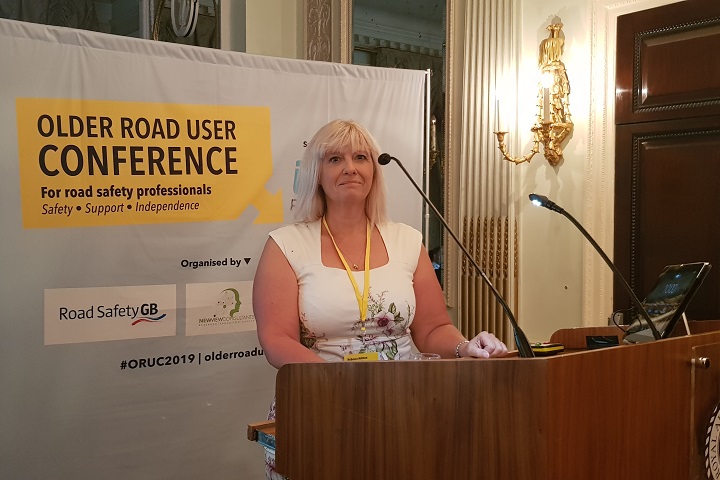
Presentation: Sponsor’s address
‘Many of the headlines we see on a daily basis in the press are not only negative, but also damaging’
Statistically, older drivers are among the safest on the roads
IAM RoadSmart lobbies on behalf of older drivers & older road users
IAM RoadSmart believes we need an open debate about older drivers
Car is essential to many older people – to avoid them becoming isolated
IAM RoadSmart Mature Driver Review:
- IAM RoadSmart is one of the leading providers of independent driving assessments for mature drivers
- Our Mature Driver Review offers an impartial, expert assessment of drivers’ capability levels
- 60 minute sessions taken in the driver’s own car
- Confidential feedback and advice is given
- Helps refresh drivers’ skill and knowledge and gives peace of mind
- Renews confidence and provides reassurance to family and friends
- Available nationwide
- Direct to consumer price £49
09.30 – Elizabeth Box, Head of Research, RAC Foundation
Elizabeth Box is head of research at the RAC Foundation, an independent charity established to promote for the public benefit research into environmental, economic, mobility and safety issues relating to the use of motor vehicles.
Presentation: Welcome to the Royal Automobile Club
‘We don’t stop playing because we get old, we get old because we stop playing’
08.45 – Welcome to the live feed
The Older Road User Conference, jointly organised by Road Safety GB in partnership with New View Consultants and the RAC Foundation, is designed to help road safety professionals keep older people safe on the roads for longer.
The conference gets underway at 9.30am.
Comment on this story